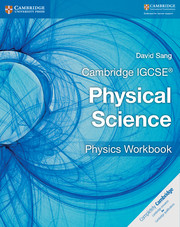- ISBN:9781316633519
- Format:Paperback
- Subject(s):Science
- Qualification:Cambridge IGCSE
- Author(s):Richard Harwood, Ian Lodge
- Available from: No date available
Cambridge IGCSE® Physical Science resources tailored to the 0652 syllabus for first examination in 2019, and all components of the series are endorsed by Cambridge International Examinations.
Send a Query
×- Contents
-
Endorsed for learner support by Cambridge International Examinations.
Exercises designed to develop skills in problem-solving and data handling, planning investigations and application of theory to practice to help students work towards the assessment objectives.
Self-assessment checklists help students to develop an evaluative approach to their work so they can track their progress as they go.
Answers to the exercises in the workbook are included at the back of the book to allow students to check their own progress and understanding.
Authored by Richard Harwood and Ian Lodge, accomplished examiners and writers who bring a wealth of experience to the book.
Covers the Core and the Supplement material for Cambridge IGCSE® Physical Science in one workbook.
-
- Introduction
- How to use this book
- C1. The particulate nature of matter
- C1.1 Changing physical state
- C1.2 Plotting a cooling curve
- C2. Experimental techniques
- C2.1 Diffusion, solubility and separation
- C2.2 Chromatography at the races
- C3. Atoms, elements and compounds
- C3.1 Atomic structure
- C3.2 The first four periods
- C3.3 The chemical bonding in simple molecules
- C3.4 The nature of ionic lattices
- C4. Stoichiometry
- C4.1 Formulae of ionic compounds
- C4.2 Making magnesium oxide – a quantitative investigation
- C4.3 The analysis of titration results
- C4.4 Calculating formula masses
- C4.5 A sense of proportion in chemistry
- C4.6 Finding the mass of 5 cm of magnesium ribbon
- C4.7 Reacting volumes of gases
- C5. Electricity and chemistry
- C5.1 The nature of electrolysis
- C5.2 Making and 'breaking' copper chloride
- C6. Energy changes in chemical reactions
- C6.1 Energy diagrams
- C6.2 The collision theory of reaction rates
- C6.3 The influence of surface area on the rate of reaction
- C6.4 Finding the rate of a reaction producing a gas
- C7. Acids, bases and salts
- C7.1 Acid and base reactions – neutralisation
- C7.2 Types of salt
- C7.3 Descaling a coffee machine
- C7.4 Thermochemistry – investigating the neutralisation of an acid by an alkali
- C8. The Periodic Table
- C8.1 Trends in the halogens
- C8.2 Displacement reactions of the halogens
- C8.3 Group I: The alkali metals
- C9. Metals
- C9.1 The reactivity series of metals
- C9.2 Energy from displacement reactions
- C9.3 Metals and alloys
- C10. Air and water
- C10.1 Atmospheric pollution, industry and transport
- C10.2 Clean water is crucial
- C11. Organic chemistry
- C11.1 Families of hydrocarbons
- C11.2 Unsaturated hydrocarbons (the alkenes)
- C11.3 The alcohols as fuels
- C11.4 Essential processes of the petrochemical industry
- C11.5 Addition polymerisation
- C12. Analysis
- C12.1 Titration analysis
- C12.2 Chemical analysis
- C12.3 Planning a controlled experiment
- C12.4 Chemical testing and evaluation
- C12.5 Experimental design
- Answers.
Thank you for your feedback which will help us improve our service.
If you requested a response, we will make sure to get back to you shortly.
×

